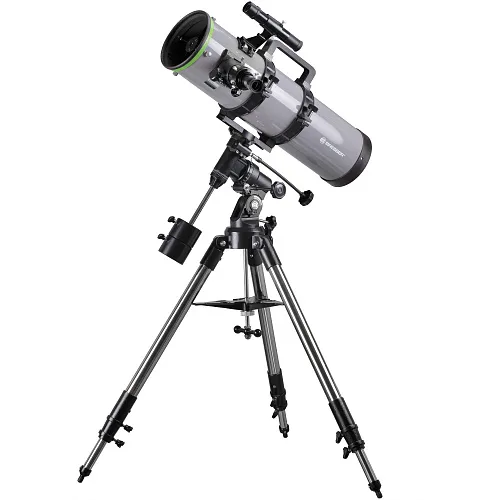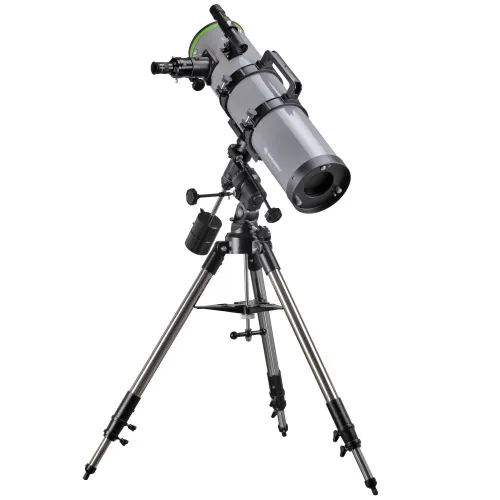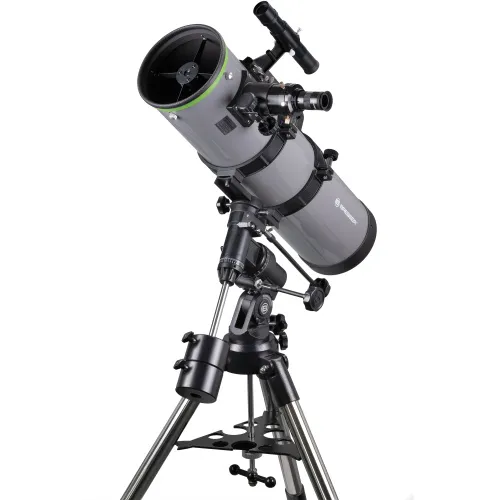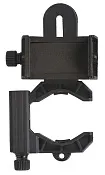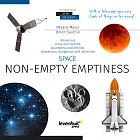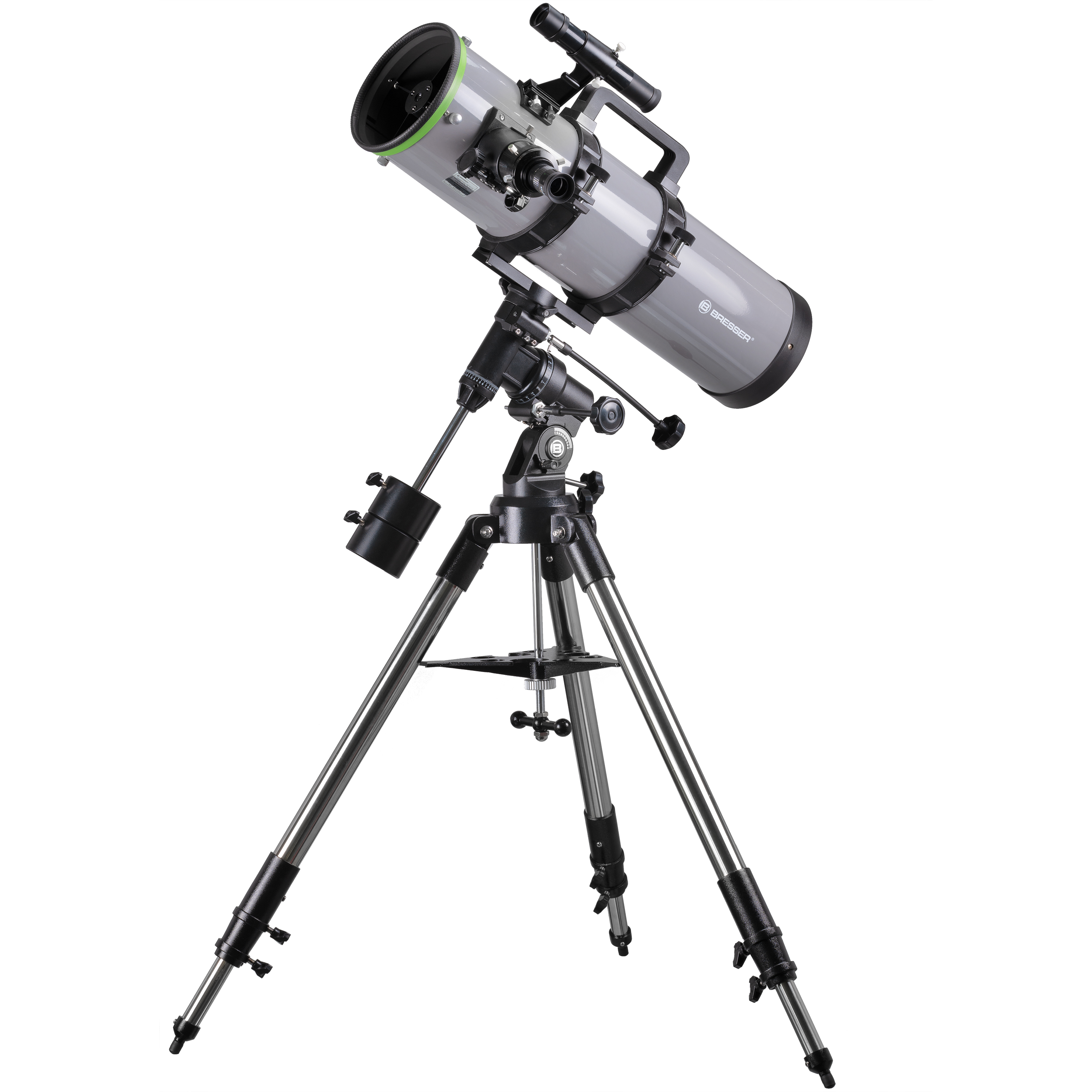Bresser Space Explorer 150/750 Telescope
Objective lens diameter: 150mm. Focal length: 750mm
| Product ID | 80099 |
| Brand | Bresser GmbH, Germany |
| Warranty | 2 years |
| EAN | 4007922075556 |
| Package size (LxWxH) | 95x54x43 cm |
| Shipping Weight | 12.5 kg |
The Bresser Space Explorer 150/750 telescope with an EQ-3 mount shows you the night sky in stunning detail. Go on a journey into distant worlds: Thanks to the combination of a large 150 mm aperture and a short 750 mm focal length, you can marvel at a vast array of celestial objects such as large nebula, open star clusters or the Andromeda galaxy. The powerful Newton reflector telescope is also great for observing our own solar system: with the 25-mm Plössl eyepiece, you can view the moon in 30x magnification. The premium parabolic primary mirror produces significantly sharper images and better contrasts than a comparable telescope with a simple spherical mirror. In addition, the telescope also has a large 55 mm secondary mirror that illuminates the field of view perfectly to create a bright image.
Portable design - with 150/750 reflector telescope
Can't wait to get out of the house to view the Orion Nebula or the Pleiades? With this telescope, you can search for the perfect observation spot: thanks to the short focal length, the tube is short and easy to transport. In addition, the premium equatorial mount allows even beginners to set up the telescope in no time. Tracking is also very simple – you can compensate for the earth's movements manually so that your observed objects stay within the field of view. To ensure maximum viewing comfort, the focuser on this Newton reflector telescope is attached to the side of the tube. The aluminium tripod is height-adjustable and features an accessory tray so that you can keep all your important gear within reach. The red dot finder allows you to align the telescope with objects in the night sky. The red point indicates the position at which your telescope is pointing. If you want to capture images of your nighttime discoveries, you can connect your smartphone to the telescope via the smartphone camera adapter.
Discover the fascinating night sky with the Bresser Space Explorer 150/750 telescope!
Features:
- Reflector telescope for nighttime observations
- Simple tracking by hand
- EQ3 equatorial mount
- Height-adjustable aluminium tripod with accessory tray
The kit includes:
- Tube
- EQ3 mount
- Height-adjustable aluminium tripod
- Plössl 10 and 25 mm eyepiece
- 6x30 finder scope
- Smartphone holder
- Instructions with warranty information
| Product ID | 80099 |
| Brand | Bresser GmbH, Germany |
| Warranty | 2 years |
| EAN | 4007922075556 |
| Package size (LxWxH) | 95x54x43 cm |
| Shipping Weight | 12.5 kg |
| Optical design | reflector |
| Optical scheme | Newtonian |
| Objective lens diameter (aperture), mm | 150 |
| Focal length, mm | 750 |
| Highest practical power, x | 300 |
| Aperture ratio | f/5 |
| Eyepieces | Plössl 10mm, Plössl 25mm |
| Finderscope | optical, 6x30 |
| Accessory tray | ✓ |
| Mount | equatorial, EQ3 |
| Additional | smartphone holder |
| User level | beginners |
| Observed object | deep-sky objects, planets of the Solar System |
Convenient diagrams that describe how to install additional accessories on refractors and catadioptric telescopes
Find out how to assemble a telescope on an example of the Levenhuk Skyline 90x900 EQ telescope
This short guide will help you avoid typical mistakes and learn more about telescope and mounting types
The basics of astronomical observations for beginners
In this article we have gathered answers to some of the most frequently asked questions about telescopes
How telescopes work?
You can actually perform observations from your balcony!
All about telescope sizes, types, magnification, and mounts
Learn how to set up and use the telescope properly
Astronomy in light-polluted skies. Find out what you can observe in the city
Read an interesting comprehensive article on telescopes for little astronomers
Celestial objects you can observe with telescopes of different apertures
Colored and vivid images of galaxies, planets and star clusters entrance everyone who is fascinated by boundless space
Find an interesting review on the history of the changes to a refracting telescope
To make the process of choosing a telescope easier, we will tell you about the characteristics of the most popular types of telescopes today
Learn everything you need to know about refractor telescopes to make the right choice

